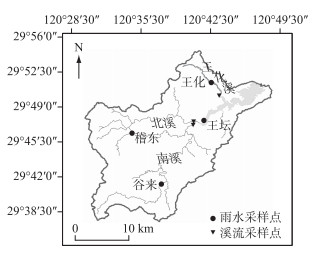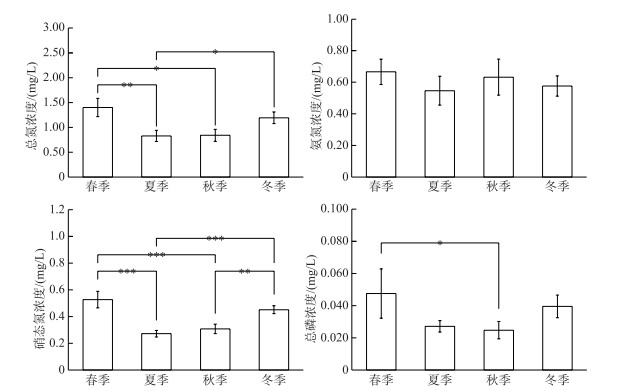(2: 浙江省舟山开源供水有限责任公司, 舟山 316021)
(3: 浙江省绍兴市公用事业集团有限公司, 绍兴 312000)
(2: Zhoushan Kaiyuan Water Supply Co., Ltd., Zhejiang Province, Zhoushan 316021, P. R. China)
(3: Shaoxing Public Utilities Group Co., Ltd., Zhejiang Province, Shaoxing 312000, P. R. China)
现代工业的快速发展、农业化肥的大量应用、生物质燃烧和高密度人口的经济社会活动,释放了大量的氮磷化合物和颗粒物[1-2].在重力作用下,大气中水溶性或颗粒态氮磷被雨、雪、雹等降水过程冲刷至地面进入生态系统,并伴随着土壤侵蚀,加剧河流、湖泊和水库等水体的富营养化[2-3].因此,作为流域非点源污染因素之一的大气氮、磷湿沉降及其生态环境效应引起了广泛关注.
我国逐步建立起监测大气氮干湿沉降的全国氮沉积监测网(NNDMN)[4]和基于中国生态系统研究网(CERN)的氮、磷沉降监测体系[5].于贵瑞等研究认为全国总氮(TN)湿沉降在2005年到达峰值后逐渐下降[6].湿沉降的氮、磷浓度和通量有着明显的季节变化、空间分布[7-8]和年际差异,结合氨氮与硝态氮的比值(NH3-N/NO3--N)可以判断主要来源于农业源或城市源[9-10].在大尺度空间上,利用HYSPLIT模型的后向轨迹模型模拟分析不同降水气团来源和输送路径[8, 10-13],王小刚通过逐小时跟踪湿沉降中NH4+、NO3-等离子浓度的变化规律,认为湿沉降对不同大气污染物净化效率不同,离子浓度变化也与降雨量、污染物排放量密切相关[13].大气湿沉降氮、磷营养随径流入湖(间接贡献)是一个复杂的过程,赵婷婷等通过入河系数对干湿沉降、生活污染源、畜禽养殖污染物、农业种植业等7种污染源进行解析[14];王金杰等引用美国宾夕法尼亚洲的氮输出系数(输出率)对汉江金水河进行估算[15];徐冯迪等运用不同土地利用类型的径流输出系数开展估算[16];考虑到营养物的迁移转化、土壤固持、植物吸收等因素,张峰在径流系数的基础上,根据离河距离建立了校正系数[17];考虑氮的降解和保留,Whitalla等根据子流域距离建立了到达河口的保留比例[18].还有研究引入δ15N和δ18O双同位素技术,解析大气来源的氮污染贡献占比[19-21].
汤浦水库作为虞绍平原重要饮用水源地之一,担负着杭州湾大湾区建设的部分水源供给,水质保证是汤浦水库的生命线.为探索大气氮、磷污染占水库外源污染输入的比重,本文在汤浦水库上游4个乡镇的主要3条入库溪流中部设置大气湿沉降采样点4处,溪流汇入口设置水质采样点3处.对流域内大气湿沉降及入库溪流营养情况进行初步观测,分析大气湿沉降中氮的数量、形态,研究氮、磷输入的时空分布规律,估算湿沉降对汤浦水库水体氮、磷负荷的直接和间接贡献量,为流域水质管理提供科学依据.
1 研究区域概况与研究方法 1.1 研究区域概况研究区为浙江省绍兴市汤浦水库流域,汤浦水库坝址位于小舜江下游的绍兴市上虞区汤浦镇,控制流域集水面积460 km2,水库水域面积13.64 km2.汇入水库的河流主要有南溪、北溪、王化溪和万乔溪,其中南溪、北溪在库前汇成双江溪.双江溪、王化溪和万乔溪的入库流量占水库总径流量的比例分别为75.4 %、13.3 %和4.3 %.流域平均海拔高度263.5 m,土壤类型主要为红壤,土地利用方式主要包括林地、水田、旱地、茶园和果园,原始山林占流域面积的75 %.流域多年平均气温17.1℃,平均降水量1530 mm.汤浦水库流域属亚热带季风性气候区,四季分明,光照充足,雨量丰沛,温暖湿润.由于处于中亚热带与北亚热带的过渡区,且地形较复杂,小气候差异明显,降雨量季节分配不均匀,其中3-9月7个月的雨量占全年降水量的80 %,梅雨季平均每年6月中旬入梅,7月上旬出梅,雨量相对集中;秋季常受台风影响,形成暴雨事件.流域2014年和2015年属于丰水年,年降雨量分别为1711和1991 mm.王化点位地处谷地的村落中心,北部、南部均有较大面积农田,两边有百米山体;王坛点位西部为山林,东部为湿地,地势较低,属于盆地边缘,离集镇和农田有1 km的距离,集镇发达,污染物不易扩散;稽东点位东部为山林,西部为农田和集镇,位于集镇边缘;谷来点位周边为开垦山地,从事农业种植、经济苗木种植等,地势较高,位于半山腰,西部200 m为村落,东部1 km为集镇. 4个雨样点附近均有公路穿过.
1.2 采样点设置与样品分析在汤浦水库流域综合考虑了流域范围、空间分布及采样便利等因素,在上游4个乡镇,主要干流中部,分别设置了具有代表性的大气氮、磷湿沉降采样点共4个(图 1),在屋顶设置人工雨量计,依据天气预报,在降雨前打开雨量计的盖子,人工采集雨水样品.于次日将收集到的满足检测用量(>500 mL)的雨水样品转移到2.5 L聚乙烯塑料壶中,同时采集入库溪流(南溪、北溪、王化溪)水样各2.5 L,送往检测单位检测. 2014年1月-2015年12月共采集大气湿沉降样品60个,溪流样品48个.每月还另外采集一次溪流样品进行检测,样品共72个.面雨量数据来自汤浦水库公司自有雨量自动监测系统,由9个监测点位按各自权重综合所得.

|
图 1 汤浦水库流域采样点分布 Fig.1 Distribution of sampling sites in Tangpu Reservoir Basin |
雨水样品分析指标为:总磷(TP)、TN、NH3-N和NO3--N. TP浓度测定参照《水质总磷的测定钼酸铵分光光度法》(GB 11893-1989),TN浓度测定参照《水质总氮的测定碱性过硫酸钾消解紫外分光光度法》(HJ 636-2012),NO3--N浓度测定参照《水质无机阴离子的测定离子色谱法》(HJ/T84-2001),NH3-N浓度测定参照《水质氨氮的测定纳氏试剂分光光度法》(HJ 535-2009),委托绍兴市水环境科学研究院有限公司进行样品检测.
1.3 数据处理无机氮(IN)浓度为NH3-N与NO3--N浓度之和.有机氮(ON)浓度为TN与IN浓度之差[22].
氮、磷湿沉降通量的计算公式[23]为:
| $ F=\sum(R \cdot C) / 100 $ | (1) |
式中,F为氮、磷的年湿沉降通量(kg/(hm2 ·a)),R为年内逐月降雨量(mm),C为雨水中TN、TP浓度(mg/L).
氮、磷湿沉降输出量的计算公式为:
| $ P=\sum\left(\mu \cdot F_{1} \cdot S_{1} / 10\right)+\sum\left(F_{2} \cdot S_{2} / 10\right) $ | (2) |
式中,P为湿沉降输出的营养物量(t);F1为月湿沉降通量(kg/(hm2 ·a));S1为上游流域面积(km2);F2为月水面湿沉降通量(kg/(hm2 ·a));S2为水域面积(km2);μ为流失系数.
数据采用Excel 2016软件整理,采用Origin 2018软件作图,地图采用ArcGIS 10.2软件绘制.
2 结果与分析 2.1 湿沉降氮、磷浓度2014-2015年汤浦水库流域各采样点雨水TN浓度范围为0.15~2.47 mg/L,平均值为1.02±0.58 mg/L;TP浓度范围为0.005~0.112 mg/L,平均值为0.033±0.028 mg/L(图 2).氮湿沉降通量约为18.15 kg/(hm2 ·a),低于本地区临界负荷[24],磷湿沉降通量约为0.62 kg/(hm2 ·a).

|
图 2 2014-2015年汤浦水库流域各采样点雨水的总氮和总磷浓度 (图中横线从下至上分别表示5 %、25 %、50 %、75 %、95 %分位数;□为平均值) Fig.2 Concentrations of total nitrogen and total phosphorus in rainwater at each site of Tangpu Reservoir Basin from 2014 to 2015 |
2014-2015年汤浦水库流域3条主要入库溪流TN浓度范围为0.82~4.81 mg/L,平均值为2.94±0.85 mg/L;NH3-N浓度范围为0.05~0.60 mg/L,平均值为0.08±0.07 mg/L;NO3--N浓度范围为0.6~4.3 mg/L,平均值为2.52±0.77 mg/L;TP浓度范围为0.12~0.30 mg/L,平均值为0.06±0.04 mg/L(图 3).

|
图 3 2014-2015年汤浦水库流域主要入库溪流氮、磷浓度 Fig.3 Concentration of nitrogen and phosphorus in the main streams of Tangpu Reservoir Basin from 2014 to 2015 |
汤浦水库水环境保护的目标水质为Ⅱ类,《地表水环境质量标准》(GB 3838-2002)中基本项目标准限值对应的TN和TP限值分别为0.5和0.025 mg/L,大气湿沉降中氮、磷平均浓度分别是该标准限值的2.04和1.32倍,湿沉降TN平均浓度达到该标准的Ⅳ类,TP平均浓度达到该标准的Ⅲ类.径流氮、磷平均浓度分别是该标准限值的5.88和2.4倍,按该评价标准,径流TN平均浓度为劣V类,TP平均浓度为Ⅳ类.径流及湿沉降的高浓度氮、磷输入对汤浦水库水环境,特别是水体富营养化会产生一定的影响.
2.3 雨水氮化学形态特征汤浦水库流域NH3-N、NO3--N、ON浓度占TN浓度的比例分别为60.65 %、34.07 %和5.28 % (表 1),与洞庭湖蒋家嘴(JJZ)点位类似[25],4个采样点无机氮的比例均高于87 %,NH3-N的比例均达55 %以上,说明汤浦水库流域大气氮湿沉降的主要成分是无机氮,特别是NH3-N.这与汤浦水库流域内汽车尾气排放、生物质燃烧以及农林业施肥活动有关[9, 26].由表 1可以看出4个采样点不同形态氮所占的比例存在一定的差异,NH3-N比例在稽东最高(66.34 %),NO3--N比例在王坛最高(38.3 %),ON比例在王化最高(12.41 %). ON来源于硝酸酯类化合物、森林等环境直接释放的还原型(尿素等)和颗粒型有机氮(花粉、生物碎屑等)[27].研究区雨水中有机氮平均含量较低,特别是谷来和稽东点位有机氮所占比例均低于2 %,与其他地区相比,汤浦水库流域有机氮沉降比例要低于长乐江流域和金水河流域[15, 17]. 4个采样点的NH3-N/NO3--N>1,说明均以农业源为主[26],其中王坛点比值最小(1.44),与其采样点附近城镇规模密切相关,是其他采样点规模的3~5倍,比值向城市源偏移.王化点位的谷地呈西北东南走向,污染物扩散方向单一,采样点附近个别月份有零星的禽类养殖,会产生尿素和氨挥发,这都可能是NH3-N、ON偏高的原因.
| 表 1 汤浦水库流域雨水氮浓度及形态组成 Tab. 1 Concentration and species composition of nitrogen in rainwater of Tangpu Reservoir Basin |
根据汤浦水库流域季节分布特点,将年划分为春季(3-5月)、夏季(6-8月)、秋季(9-11月)和冬季(12-2月).由图 4可以看出,雨水的TN、NO3--N和TP平均浓度在时间上呈现较明显的季节性变化,TN和NO3--N浓度在时间上的变化具有一致性,以春、冬两季最高(春季>冬季>秋季>夏季),且表现出夏、秋、冬季逐渐升高的特点,TN浓度最低值出现在夏季(0.83±0.11 mg/L),与春季、冬季呈显著差异(P≤0.05);NO3--N浓度最低值出现在夏季(0.27±0.23 mg/L),与春、冬季呈显著差异(P≤0.01);NH3-N浓度的季节性差异不显著;TP浓度在不同季节的变化趋势表现为:冬季>春季>夏季>秋季,仅春季与秋季差异显著(P≤0.05).冬、春季降雨频率低强度小,因长时间富集空气中氮、磷营养物质含量较高,一次降雨则雨水中氮、磷浓度较高;夏、秋季降雨频率高强度大,经多次冲刷雨水中氮、磷浓度较低[28].总体而言,汤浦水库流域雨水氮、磷浓度表现出冬、春季(少雨季)高于夏、秋季(多雨季)的特点,和长三角地区[29]、重庆丰都[9]的现象相同.

|
图 4 汤浦水库流域湿沉降氮、磷浓度的季节性变化 (*P≤0.05,P≤0.01,P≤0.001;Fisher's LSD检验) Fig.4 Seasonal changes of nitrogen and phosphorus concentration in the wet deposition of Tangpu Reservoir Basin |
各采样点雨水的TN、TP平均浓度存在明显的时空差异特征,但TN、TP的空间分布表现不同(图 2, 表 1).各采样点雨水的TN和NH3-N浓度空间分布一致:王化>稽东>王坛>谷来,NO3--N和有机氮浓度大小为:王化>王坛>稽东>谷来,TP浓度大小为:王化>王坛>谷来>稽东,王化点位雨水的各形态氮和TP浓度显著高于其他3个采样点(P < 0.05).汤浦水库流域是小尺度流域,4个采样点之间的空间跨度较小,雨水中的各形态氮和TP浓度在空间上表现出一定的变化趋势且达到显著水平(P < 0.05),主要是受到人为干扰作用的影响.与其他地区比较,氮湿沉降浓度高于植被覆盖度更高的金水河流域[15],明显低于流域经济水平更高、单位人口数量更多的长乐江流域[17]和太湖流域[7].
| 表 2 不同湖面湿沉降总氮和总磷年度沉降总量占入湖总负荷比例的比较 Tab. 2 Comparison of annual wet deposition of total nitrogen and total phosphorus on different lake surfaces contribute to loading of lakes |
汤浦水库流域面积460 km2,其中库面面积13.64 km2,根据同期入库河流水质水量月度监测结果,入库的TN和TP年均污染负荷分别占1364.83和26.89 t,其中NO3--N和NH3-N为1137.11和43.76 t,分别占TN的83.3 %和3.2 %.库面年均TN和TP湿沉降总量为24.14和0.82 t,分别占河流入库负荷的1.77 %和3.07 %.在气候相似的湖泊水库中,依据表 2计算可得,占2.97 %流域面积的湖面,滇池湿沉降输入的TN、TP负荷占河流入湖总负荷的比例为1.71 %和3.55 %,太湖为2.32 % ~4.49 %和1.16 % ~2.87 %,巢湖为17.11 %和3.32 %,其中汤浦水库TN湖面输入占入湖总负荷的比例与滇池类似,是太湖的一半,是巢湖的1/10;汤浦水库TP湖面输入占入湖总负荷的比例与滇池、巢湖差异较小,是太湖低值年份的2.7倍.翟水晶等研究认为氮、磷湿沉降有助于北太湖夏、秋季蓝藻水华的发生[30],因此在输入占比差距不明显的情况下,湿沉降在汤浦水库可能会产生相似的生态影响.湖面输入占比的计算易受到入库水量、各支流入湖营养浓度、沉降浓度、沉降总量等多种因子检测和统计的影响,从而形成数据的偏差.
2.6 氮、磷湿沉降对汤浦水库间接贡献率的估算间接贡献率是从流域角度考虑氮、磷收支,输入项目包括:大气沉降、化肥施用、生物固定、饲料输入等;输出项目包括:地表径流、淋失、氨挥发、反硝化、产品输出等[39];土壤库属于多年积累的本底内源.其中氮、磷湿沉降属于流域营养输入元素之一,河流入库污染负荷量则是流域输出元素之一.
根据入库溪流水质(图 3)分析可知,主要入库溪流中NH3-N和NO3--N浓度分别占年均TN浓度的2.1 %和85.7 %,这与雨水氮组分中NH3-N占主导(表 1)有很大差异.在稻麦轮作试验中也发现类似的现象,坑面水中NH3-N占TN的90 %以上,渗漏水则以NO3--N为主,占TN的85 %以上[40].在大气湿沉降后,降水中氮、磷营养物质部分被土壤固持、植物吸收.带有正电荷的NH4+被土壤吸附,吸附能力为0.67~1.02 mg/g[41],吸附量达到90 %平衡值只需10 min左右,解吸速率比吸附速率慢18倍[42].土柱试验淋滤模拟证实NH4+迁移较慢[43],HYDRUS-1D软件模拟表明,NH4+在弱透水层的迁移速度为0.06~0.36 m/a[44],在毛竹林以1.31~4.78 mg/(kg ·d)的硝化速率形成NO3-[45]. NO3-在弱透水层的迁移速度为27.66~115.63 m/a[44],较NH4+更容易淋失.在温度水分合适的条件下,土壤中氮素的形式可以迅速转化,最终达到动态平衡.番茄黄瓜轮作试验显示常规施肥组氮素淋失系数(淋溶氮量占施氮量的%)平均为10.64 % [46],对大尺度面源氮负荷核算分析认为,2011年全国种植业氮素(径流+淋洗)总损失量占氮肥投入量的12.3 % [47],赵柳惠通过文献资料讨论认为氮肥流失系数取11 %比较合适[48].我们假设氮湿沉降也是一种肥料,将TN流失系数取11 %,根据公式(2)计算,流域大气湿沉降源的氮流失量为113.26 t,约占河流输出TN负荷的8.3 %,略低于表 3中其他流域湿沉降来源年度输出量占入湖(河流)负荷的比例.研究显示汉江上游金水河流域氮湿沉降对水体贡献率占流域氮肥贡献量为5.05 % ~6.78 % [15],江西千烟洲香溪流域为4.3 % ~5.7 % [49].由于径流中NO3--N占绝对优势,使用δ15N和δ18O双同位素技术,利用质量均衡模型、SIAR模型等方法对硝酸盐来源进行定量识别,研究表明大气沉降来源的NO3--N占入湖(河流)负荷的2 % ~8 % [20-21],从而间接对TN进行溯源.
| 表 3 不同流域湿沉降来源的总氮和总磷年度输出量占入湖(河流)负荷比例的比较 Tab. 3 Comparison of annual output of total nitrogen and total phosphorus from wet deposition in different basins to loading of lakes (rivers) |
土壤对磷有较强的吸附能力,为0.3~0.6 mg/g[41],在降雨的过程中由于降雨侵蚀和径流侵蚀,会增加土壤中颗粒态磷的流失.在对长乐江流域不同污染源分析表明大气磷沉降占污染物输入(投排放)总量的1 % [17].在对江西千烟洲香溪流域进行磷沉降研究认为,P沉降输出系数为0.06 % ~0.15 % [1].根据全国污染源普查数据,南方山地丘陵区肥料中TP流失系数为0.072 % ~1.547 % [54].我们假设磷湿沉降也是一种肥料,将TP流失系数取1.547 %,则流域大气湿沉降源的磷流失量为1.25 t,约占河流输出TP负荷的4.6 %,明显高于表 3中千烟洲香溪流域和长乐江流域,略低于表 3中漕桥河流域和杭嘉湖流域.
3 结论与展望1) 从NH3-N/NO3--N比值角度分析,汤浦水库流域4个采样点湿沉降以农业源为主,其中王坛点位的比值向城市源偏移.
2) 在时间尺度上,雨水氮、磷浓度呈现明显的季节性差异,总体而言,汤浦水库流域雨水氮、磷浓度表现出冬、春季(少雨季)高于夏、秋季(多雨季)的特点.空间上,王化点位的各形态氮和TP浓度显著高于其他3个采样点.
3) 氮、磷湿沉降占河流入库负荷的直接贡献率和间接贡献率均低于10 %,间接贡献率较直接贡献率增幅有限.因此在河湖长制工作的外源污染物治理中,需定期收集掌握不同土地利用类型等多污染源的数量变化动态,分析各污染源的贡献率,甄别重点污染,针对性地开展工程修复措施.
本文所收集的大气湿沉降基本可反映当时区域内湿沉降的时空变化,但仍有许多不足.大气湿沉降营养通量受影响因素较多,需结合气象条件多年跟踪分析,并排除偶然性影响.未来可引进湿沉降自动采样装置,弥补人工采样的不足.对于洪水期流域营养输出应加密水质监测频次.引入河流自净量,结合降雨强度,利用SWAT等分析模型,更科学地开展估算分析.
致谢: 感谢斯坦福大学余继业老师、温州大学李仁辉老师、绍兴文理学院王斌梁老师等在论文修改中提供的帮助.
| [1] |
Gao Y, Hao Z, Yang TT et al. Effects of atmospheric reactive phosphorus deposition on phosphorus transport in a subtropical watershed:A Chinese case study. Environmental Pollution, 2017, 226: 69-78. DOI:10.1016/j.envpol.2017.03.067 |
| [2] |
Luo LC, Qin BQ, Yang LY et al. Total inputs of phosphorus and nitrogen by wet deposition into Lake Taihu, China. Hydrobiologia, 2007, 581: 63-70. DOI:10.1007/s10750-006-0515-3 |
| [3] |
Koelliker Y, Totten LA, Gigliotti CL et al. Atmospheric wet deposition of total phosphorus in New Jersey. Water Air & Soil Pollution, 2004, 154(1): 139-150. |
| [4] |
Xu W, Zhang L, Liu X. A database of atmospheric nitrogen concentration and deposition from the nationwide monitoring network in China. Scientific Data, 2019, 6: 1-6. DOI:10.1038/s41597-018-0005-2 |
| [5] |
Zhu JX, Wang QF, He NP et al. Imbalanced atmospheric nitrogen and phosphorus depositions in China:Implications for nutrient limitation. Journal of Geophysical Research: Biogeosciences, 2016, 121(6): 1605-1616. DOI:10.1002/2016JG003393 |
| [6] |
Yu GR, Jia YL, He NP et al. Stabilization of atmospheric nitrogen deposition in China over the past decade. Nature Geoscience, 2019, 12(6): 424-429. DOI:10.1038/s41561-019-0352-4 |
| [7] |
Yu H, Zhang LL, Yan SW et al. Atmospheric wet deposition characteristics of nitrogen and phosphorus nutrients in Taihu Lake and contributions to the lake. Research of Environmental Sciences, 2011, 24(11): 1210-1219. [余辉, 张璐璐, 燕姝雯等. 太湖氮磷营养盐大气湿沉降特征及入湖贡献率. 环境科学研究, 2011, 24(11): 1210-1219.] |
| [8] |
Wang JF, Zhou KJ, Wang XQ et al. Atmospheric nitrogen and phosphorous deposition in Hangjiahu are. China Environmental Science, 2015, 35(9): 2754-2763. [王江飞, 周柯锦, 汪小泉等. 杭嘉湖地区大气氮、磷沉降特征研究. 中国环境科学, 2015, 35(9): 2754-2763.] |
| [9] |
Duan SH, Jiang YJ, Zhang YZ et al. Characteristics and sources of atmospheric inorganic nitrogen wet deposition in Xueyudong watershed, outer suburbs of Chongqing City. Environmental Science, 2018, 39(10): 4479-4489. [段世辉, 蒋勇军, 张远瞩等. 重庆远郊丰都雪玉洞流域大气无机氮湿沉降变化特征与来源分析. 环境科学, 2018, 39(10): 4479-4489.] |
| [10] |
Xing JW, Song JM, Yuan HM et al. Fluxes, seasonal patterns and sources of various nutrient species (nitrogen, phosphorus and silicon) in atmospheric wet deposition and their ecological effects on Jiaozhou Bay, North China. Science of the Total Environment, 2017, 576(15): 617-627. |
| [11] |
Ma YB, Xu Q, Gao DQ et al. Composition of hydrogen and oxygen isotope in precipitation and source apportionment of water vapor in the wetland forest area of Tangpu Reservoir, Zhejiang Province. Forest Research, 2018, 31(3): 37-44. [马迎宾, 徐庆, 高德强等. 汤浦水库湿地森林区大气降水氢氧同位素特征及水汽来源. 林业科学研究, 2018, 31(3): 37-44.] |
| [12] |
Wang JF. Atmospheric deposition of nitrogen and its effect on the water environment in the Hanhjiahu area[Dissertation]. Hangzhou: Zhejiang University of Technology, 2015. [王江飞.杭嘉湖大气氮、磷沉降特征及其对水环境的影响[学位论文].杭州: 浙江工业大学, 2015. ]
|
| [13] |
Wang XG. Chemical composition and atmosphere pollutant source of wet deposition in Chang'an District, Xi'an City[Dissertation]. Xi'an: Northwest University, 2018. [王小刚.湿沉降化学组成与大气污染源研究[学位论文].西安: 西北大学, 2018. ]
|
| [14] |
Zhao TT, Li QY, Lu LQ et al. Analysis of water environmental pollution in plain river network region in small watershed of Caoqiao River. Transactions of the Chinese Society of Agricultural Engineering, 2011, 27(S2): 170-175. [赵婷婷, 李秋艳, 陆丽巧等. 漕桥河小流域平原河网地区水环境污染分析. 农业工程学报, 2011, 27(S2): 170-175.] |
| [15] |
Wang JJ, Zhang KR, Wu C. Wet deposition of atmospheric nitrogen of the Jinshui watershed in the upper Hanjiang river. Environmental Science, 2014, 35(1): 66-72. [王金杰, 张克荣, 吴川等. 汉江上游金水河流域氮湿沉降. 环境科学, 2014, 35(1): 66-72.] |
| [16] |
Xu FD, Gao Y, Dong WY et al. Impact of atmospheric nitrogen and phosphorus wet deposition on nitrogen and phosphorus export and associated water quality:a case study of forest watershed in the red soil area, Southern China. Acta Ecologica Sinica, 2016, 36(20): 6409-6419. [徐冯迪, 高扬, 董文渊等. 我国南方红壤区氮磷湿沉降对森林流域氮磷输出及水质的影响. 生态学报, 2016, 36(20): 6409-6419.] |
| [17] |
Zhang F. Atmospheric deposition of nitrogen and phosphorus and its contribution in the regional nutrients circulation in Changle river watershed[Dissertation]. Hangzhou: Zhejiang University, 2011. [张峰.长乐江流域大气氮、磷沉降及其在区域营养物质循环中的贡献[学位论文].杭州: 浙江大学, 2011. ]
|
| [18] |
Whitalla D, Hendricksonb B, Paerlb H. Importance of atmospherically deposited nitrogen to the annual nitrogen budget of the Neuse River estuary, North Carolina. Environment International, 2003, 29(2): 393-399. |
| [19] |
Deutsch B, Mewes M, Liskow I et al. Quantification of diffuse nitrate inputs into a small river system using stable isotopes of oxygen and nitrogen in nitrate. Organic Geochemistry, 2006, 37(10): 1333-1342. DOI:10.1016/j.orggeochem.2006.04.012 |
| [20] |
Zhao QL, Ma HY, Ren YF et al. δ15N-NO3- and δ18O-NO3- tracing of nitrate sources in Beijing Urban Rivers. Environmental Science, 2016, 37(5): 1692-1698. [赵庆良, 马慧雅, 任玉芬等. 利用δ15N-NO3-和δ18O-NO3-示踪北京城区河流硝酸盐来源. 环境科学, 2016, 37(5): 1692-1698.] |
| [21] |
Xue DM, De BB, Van CO et al. Use of a bayesian isotope mixing model to estimate proportional contributions of multiple nitrate sources in surface water. Environmental Pollution, 2012, 161: 43-49. DOI:10.1016/j.envpol.2011.09.033 |
| [22] |
Song HH, Jiang CM, Yu WT. Basic features and monitoring methodologies of atmospheric nitrogen deposition. Chinese Journal of Applied Ecology, 2014, 25(2): 599-610. [宋欢欢, 姜春明, 宇万太. 大气氮沉降的基本特征与监测方法. 应用生态学报, 2014, 25(2): 599-610.] |
| [23] |
Chen NW, Hong HS, Zhang LP. Wet deposition of atmospheric nitrogen in Jiulong River watershed. Environmental Science, 2008, 29(1): 38-46. [陈能汪, 洪华生, 张珞平. 九龙江流域大气氮湿沉降研究. 环境科学, 2008, 29(1): 38-46.] |
| [24] |
Liu XJ, Duan L, Mo JM et al. Nitrogen deposition and its ecological impact in China:An overview. Environmental Pollution, 2011, 159(10): 2251-2264. DOI:10.1016/j.envpol.2010.08.002 |
| [25] |
Zhang Y, Liu CM, Liu XJ et al. Atmospheric nitrogen deposition around the Dongting Lake, China. Atmospheric Environment, 2019, 207: 197-204. DOI:10.1016/j.atmosenv.2019.03.034 |
| [26] |
Zhao X, Yan XY, Xiong ZQ et al. Spatial and temporal variation of inorganic nitrogen wet deposition to the Yangtze River Delta Region, China. Water Air & Soil Pollution, 2009, 203(1): 277-289. |
| [27] |
Shi JH, Gao HW, Zhang J. Atmospheric organic nitrogen deposition and significance in marine ecosystem. Advances in Earth Science, 2006, 21(7): 721-729. [石金辉, 高会旺, 张经. 大气有机氮沉降及其对海洋生态系统的影响. 地球科学进展, 2006, 21(7): 721-729.] |
| [28] |
Li L. Nitrogen and phosphorus loading from different sources in Dianchi lake and its contributions of different components[Dissertation]. Taiyuan: North University, 2016. [李乐.滇池不同来源氮磷负荷及形态组成贡献[学位论文].太原: 中北大学, 2016. ]
|
| [29] |
Chen ZL, Huang T, Huang XH et al. Characteristics, sources and environmental implications of atmospheric wet nitrogen and sulfur deposition in Yangtze River Delta. Atomspheric Environment, 2019, 219: 116904. DOI:10.1016/j.atmosenv.2019.116904 |
| [30] |
Zhai SJ, Yang LY, Hu WP. Observations of atmospheric nitrogen and phosphorus deposition during the period of algal bloom formation in Northern Lake Taihu, China. Environmental Management, 2009, 44(3): 542-551. DOI:10.1007/s00267-009-9334-4 |
| [31] |
Ren JG, Jia HB, Jiao LX et al. Characteristics of nitrogen and phosphorus forming in atmospheric deposition in Dianchi Lake and their contribution to lake loading. Environmental Science, 2019, 40(2): 582-589. [任加国, 贾海斌, 焦立新等. 滇池大气沉降氮磷形态特征及其入湖负荷贡献. 环境科学, 2019, 40(2): 582-589.] |
| [32] |
Qiu M. Study on atmospheric deposition of nitrogen and phosphorus and simulating experiment of self-purification of water body in Lake Taihu[Dissertation]. Guangzhou: Jinan University, 2017. [邱敏.太湖氮磷大气沉降及水体自净模拟实验研究[学位论文].广州: 暨南大学, 2017. ]
|
| [33] |
Wei DX, Li X, Zhao YH et al. Analyses of atmospheric nitrogen and phosphorus deposition at Hefei Science Island and its impact on Chaohu Lake. Journal of Hefei University of Technology:Natural Science, 2018, 41(9): 1259-1266. [魏东霞, 李璇, 赵禹恒等. 合肥科学岛大气氮磷沉降及对巢湖影响的分析. 合肥工业大学学报:自然科学版, 2018, 41(9): 1259-1266.] |
| [34] |
Yin LL. Spatial-temporal distribution and atmospheric nutritive salt and heavy metals into the lake of Wuliangsuhai Lake[Dissertation]. Hohhot: Inner Mongolia Agricultural University, 2014. [尹琳琳.乌梁素海大气氮、磷营养盐及重金属沉降的分异规律与入湖量核算[学位论文].呼和浩特: 内蒙古农业大学, 2014. ]
|
| [35] |
Zhang T. Research on the spatio-teraporal distribution of the concentrations of nitrogen and phosphorus and exogenous fluxes in Erhai Lake[Dissertation]. Dali: Dali University, 2011. [张态.洱海氮磷时空分布特征及其外源负荷研究[学位论文].大理: 大理学院, 2011. ]
|
| [36] |
Zhang XJ, Lu JP, Ma TL et al. Wet deposition of atmospheric nitrogen and phosphorus and its impact on water environment of reservoir in Sand source area. Ecology and Environmental Sciences, 2017, 26(12): 2093-2101. [张晓晶, 卢俊平, 马太玲等. 大气氮磷湿沉降特征及对沙源区水库水环境的影响. 生态环境学报, 2017, 26(12): 2093-2101.] |
| [37] |
Zhang WR. A study on the Dahekou Reservoir nitrogen pollution characteristics and source apportionment by isotope technology[Dissertation]. Hohhot: Inner Mongolia Agricultural University, 2017. [张文瑞.大河口水库氮污染特征及同位素源解析研究[学位论文].呼和浩特: 内蒙古农业大学, 2017. ]
|
| [38] |
Lin GE. The dynamics and budget of nitrogen and phosphorus in Reservoir Liuxihe[Dissertation]. Guangzhou: Jinan University, 2009. [林国恩.流溪河水库氮磷营养盐动态与收支分析[学位论文].广州: 暨南大学, 2009. ]
|
| [39] |
Chen NW, Hong HS, Zhang LP et al. Nitrogen sources and exports in an agricultural watershed in Southeast China. Biogeochemistry, 2008, 87(2): 169-179. |
| [40] |
Tang H, Qiu WG, Zhou X et al. Study on nitrogen losses characteristics and control countermeasures of rice-wheat rotation. Yellow River, 2010, 32(6): 64-66, 68. [唐浩, 邱卫国, 周翾等. 稻麦轮作条件下氮素流失特性及控制对策研究. 人民黄河, 2010, 32(6): 64-66, 68.] |
| [41] |
Wei Y. Studies on pollutant reduction of storm water runoff through topsoil[Dissertation]. Xi'an: Xi'an University of Architecture and Technology, 2014. [魏颖.土壤表层对径流污染物的削减效应研究[学位论文].西安: 西安建筑科技大学, 2014. ]
|
| [42] |
Sun DZ, Li XQ, Pan XF. Ammonia absorption/desorption behavior in soil. Environmental Science & Technology, 2007, 30(8): 16-18, 111, 116. [孙大志, 李绪谦, 潘晓峰. 氨氮在土壤中的吸附/解吸动力学行为的研究. 环境科学与技术, 2007, 30(8): 16-18, 111, 116.] |
| [43] |
Ruan XH, Wang C, Zhu L. Migration and transformation of nitrogen in water logged aeration zone of soil. Journal of Hehai University, 1996, 24(2): 51-55. [阮晓红, 王超, 朱亮. 氮在饱和土壤层中迁移转化特征研究. 河海大学学报, 1996, 24(2): 51-55.] |
| [44] |
Miao JJ, Ma Z, Liu HW et al. Evaluation of the vulnerability of a leaky aquifer considering the retardation effect of an aquitard for specific pollutants:case study in the Tongzhou Plain, China. Hydrogeology Journal, 2020, 28: 687-701. DOI:10.1007/s10040-019-02078-w |
| [45] |
Liu QR, Qi LH, Hu X et al. Effects of nitrogen fertilization on nitrification and denitrification in Phyllostachys edulis forests. Journal of Nanjing Forestry University:Natural Sciences Edition, 2017, 41(1): 82-88. [刘琦蕊, 漆良华, 胡璇等. 氮肥对毛竹林土壤硝化和反硝化作用的影响. 南京林业大学学报:自然科学版, 2017, 41(1): 82-88.] |
| [46] |
Liu XT, Zhao Y, Luo JH et al. Fertilization modes affect soil nitrogen loss in tomato-cucumber rotation systemand vegetable yield. Chinese Agricultural Science Bulletin, 2019, 35(4): 7-14. [刘晓彤, 赵营, 罗健航等. 不同施肥管理模式对番茄-黄瓜轮作体系土壤氮素流失及蔬菜产量的影响. 中国农学通报, 2019, 35(4): 7-14.] |
| [47] |
Xia YQ, Yang WX, Shi WM et al. Estimation of non-point source N emission in intensive cropland of China. Journal of Ecology and Rural Environment, 2018, 34(9): 782-787. [夏永秋, 杨旺鑫, 施卫明等. 我国集约化种植业面源氮发生量估算. 生态与农村环境学报, 2018, 34(9): 782-787.] |
| [48] |
Zhao LH. The temporal and spatial characteristic of agriculture non-point source pollution and its economic factors in Zhejiang province[Dissertation]. Hangzhou: Zhejiang Gongshang University, 2015. [赵柳惠.浙江省农业面源污染时空特征及经济驱动因素分析[学位论文].杭州: 浙江工商大学, 2015. ]
|
| [49] |
Hao Z, Gao Y, Zhang JZ et al. Characteristics of atmospheric nitrogen wet deposition and associated impact on N transport in the watershed of red soil area in southern China. Environmental Science, 2015, 36(5): 1630-1638. [郝卓, 高扬, 张进忠等. 南方红壤区氮湿沉降特征及其对流域氮输出的影响. 环境科学, 2015, 36(5): 1630-1638.] |
| [50] |
Wang HX, Pang SJ, Wang XY et al. Atmospheric nitrogen dry and wet deposition in small catchment. Environmental Science, 2018, 39(12): 5365-5374. [王焕晓, 庞树江, 王晓燕等. 小流域大气氮干湿沉降特征. 环境科学, 2018, 39(12): 5365-5374.] |
| [51] |
Deng OP, Sun SY, Lv J. Nitrogen non-point source pollution identification based on ArcSWAT in Changle River. Environmental Science, 2013, 34(4): 1284-1290. [邓欧平, 孙嗣旸, 吕军. 基于ArcSWAT模型的长乐江流域非点源氮素污染源识别和分析. 环境科学, 2013, 34(4): 1284-1290.] |
| [52] |
Paerl HW, Dennis RL, Whitall DR. Atmospheric deposition of nitrogen:implications for nutrient over-enrichment of coastal waters. Estuaries, 2002, 25(4): 677-693. DOI:10.1007/BF02804899 |
| [53] |
Clark HD, Kremer JN. Estimating direct and episodic atmospheric nitrogen deposition to a coastal waterbody. Marine Environmental Research, 2005, 59(4): 349-366. DOI:10.1016/j.marenvres.2004.06.001 |
| [54] |
The First China Pollution Source Census Leading Group Office of State Council ed. Manual on fertilizer loss coefficient of agricultural pollution source of the first China pollution source census, 2009: 51-113. [国务院第一次全国污染源普查领导小组办公室.第一次全国污染源普查农业污染源肥料流失系数手册, 2009: 51-113. ]
|
 2020, Vol. 32
2020, Vol. 32 

